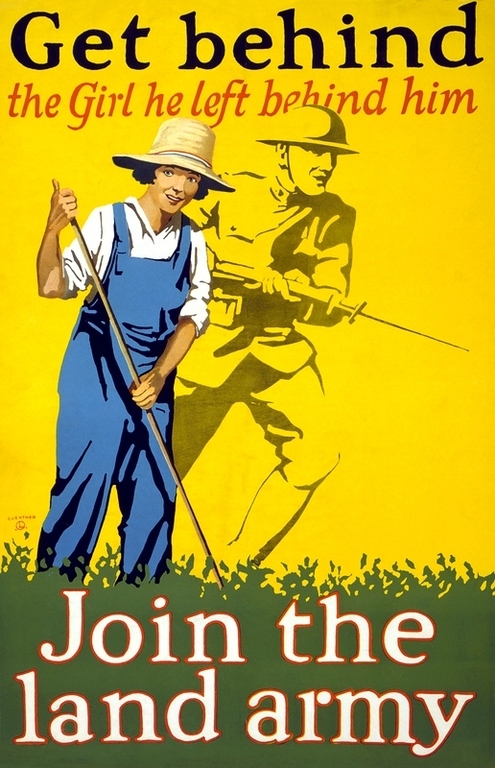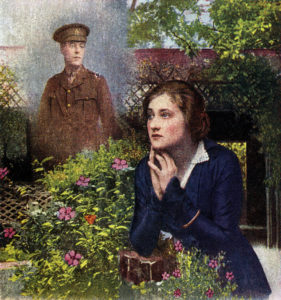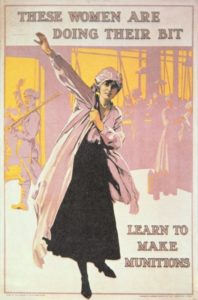Large shady hats and no sun-bonnets
To coincide with the conference and community events being held in St Andrews from the 18th – 23rd of June on The Home Front we have selected a range of items from the Russell Cawthorn (WWI) Collection to display in the Main Library.

In 1915 The Manchester Guardian published an article The Woman Harvester: Hints for the Amateur Worker in the Fields dispelling the myth of working in the countryside as “a question of sun-bonnets and shady elms and cool-refreshing drinks”. The article goes on to explain the reality of agricultural work while providing hints on suitable clothing (“the largest, shadiest hat should be chosen”) and advising women on the need to pace themselves when first taking up the manual labour. This is just one of many examples of how women needed to adapt to a new way of living.
Caroline Scott’s Holding the Home Front focuses on the Women’s Land Army during the First World War starting from the initial call for women to take up agricultural work to the official recruitment call for The Women’s Land Army in 1917 and beyond.
Great War Britain: the First World War at Home by Lucinda Gosling highlights how the conflict came to dominate many aspects of civilian life and provides a feminine perspective of life on the home front. The book starts with a description of how the content of popular weekly magazines such as The Tatler changed to incorporate war-related content alongside the more traditional articles on fashion and society. A chapter on Women and Work considers this in more depth drawing on examples from issues of The Queen which encouraged women to take up work in munition factories and many of the other posts vacated by men who had gone to war.
As well as the many titles which focus on the important role women had to play in industry there are other books in the collection which consider the contribution women made through charity work and fundraising.
What becomes apparent when reading many of these books and the newspapers from the period is the way everything was adapted to accommodate this new way of living. In addition to the many posters and documents encouraging women to support the war effort, adverts for services and products targeted at women also changed. A look through the books shows adverts from the British School of Motoring offering driving lessons for ladies (to provide women with the opportunity to have a broader range of jobs during the war), Royal Vinola Cream as being described as the ideal beauty product for munition workers, and many clothing stores including Harrods advertising reliable outfits such as Bedford breeches rather than the usual fashion items.

Margot Asquith’s Great War Diary 1914-1916: the View from Downing Street covers the period when her husband was Prime Minister. In the diary she describes and gives us an insight into political events as a participant as well as a spectator.
Home Fires Burning: the Great War Diaries of Georgina Lee, 1914-1919. Georgina Lee spent 1914-1919 at home in Britain and her diaries (written to her infant son so he could understand the war when he was old enough) allow us to see what day- to-day life was like on the British Home Front. Her involvement with the domestic war effort documents the food shortages as Britain was blockaded.
Letters from a Lost Generation: the First World War Letters of Vera Brittain and four friends is a collection of letters which spans the duration of the conflict and offers us both male and female perspectives. Alongside the experiences of a young officer in the trenches are the experiences of volunteer nurses at home and abroad and an indication as to what life was like for the civilian population.

Visit us this week in the Main Library and see our display of some of the books which give us an insight into the role of women during the war. Alternatively you can find these and all the other titles in the Russell Cawthorn Collection listed in the library catalogue.
On Saturday 23rd June please come along to our Show and Tell Event to see some of the the surviving documents, books and records dating from World War I held in Special Collections. Turn the pages and get close up to letters home from the front, diaries which tell the story of life in Fife during the war, photographs of soldiers and women, and explore the important role played by the University in support of the war effort.
Image details
[1] Women’s Land Army recruitment poster. [Photograph]. Encyclopædia Britannica ImageQuest. Retrieved 15 Jun 2018, from
https://quest.eb.com/search/132_1488238/1/132_1488238/cite
[2] When You Come Home – WWI postcard. [Photograph]. Encyclopædia Britannica ImageQuest. Retrieved 15 Jun 2018, from
https://quest.eb.com/search/113_1838274/1/113_1838274/cite
[3] Poster depicting women making munitions [Colour Lithograph]. Encyclopædia Britannica ImageQuest. Retrieved 15 Jun 2018, from https://quest.eb.com/search/108_4085817/1/108_4085817/cite